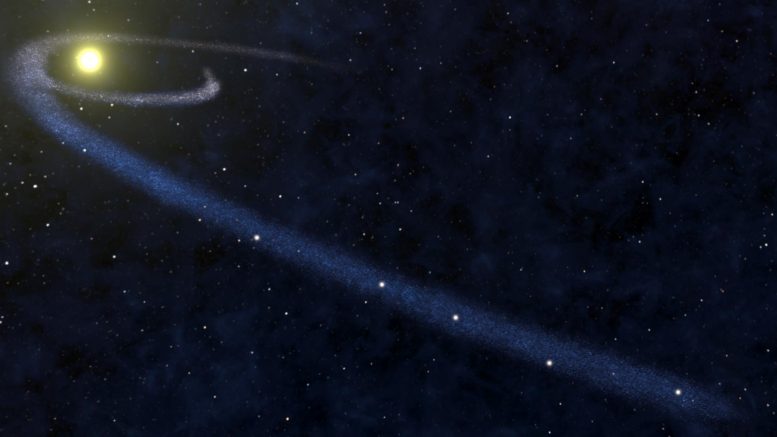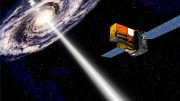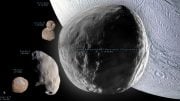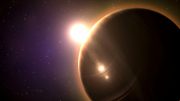
Artist’s impression of a thin gas cloud formed by tidal disruption from a passing star. Scientists think this is one of the possible ways the cold clump of gas detected in the study could have been formed. Credit: Mark Myers/OzGrav
Distant galaxies used as ‘locator pins’ to detect ‘invisible’ gas cloud.
Half of the universe’s matter is ‘missing,’ but PhD student Yuanming Wang has developed an ingenious method to help track it down.
Astronomers have for the first time used distant galaxies as ‘scintillating pins’ to locate and identify a piece of the Milky Way’s missing matter.
For decades, scientists have been puzzled as to why they couldn’t account for all the matter in the universe as predicted by theory. While most of the universe’s mass is thought to be mysterious dark matter and dark energy, 5 percent is ‘normal matter’ that makes up stars, planets, asteroids, peanut butter, and butterflies. This is known as baryonic matter.
However, direct measurement has only accounted for about half the expected baryonic matter.
Yuanming Wang, a doctoral candidate in the School of Physics at the University of Sydney, has developed an ingenious method to help track down the missing matter. She has applied her technique to pinpoint a hitherto undetected stream of cold gas in the Milky Way about 10 light years from Earth. The cloud is about a trillion kilometers long and 10 billion kilometers wide but only weighs about the mass of our Moon.
The results, published in the Monthly Notices of the Royal Astronomical Society, offer a promising way for scientists to track down the Milky Way’s missing matter.
“We suspect that much of the ‘missing’ baryonic matter is in the form of cold gas clouds either in galaxies or between galaxies,” said Ms. Wang, who is pursuing her PhD at the Sydney Institute for Astronomy.
“This gas is undetectable using conventional methods, as it emits no visible light of its own and is just too cold for detection via radio astronomy,” she said.
What the astronomers did is look for radio sources in the distant background to see how they ‘shimmered’.
“We found five twinkling radio sources on a giant line in the sky. Our analysis shows their light must have passed through the same cold clump of gas,” Ms. Wang said.
Just as visible light is distorted as it passes through our atmosphere to give stars their twinkle, when radio waves pass through matter, it also affects their brightness. It was this ‘scintillation’ that Ms. Wang and her colleagues detected.
Dr. Artem Tuntsov, a co-author from Manly Astrophysics, said: “We aren’t quite sure what the strange cloud is, but one possibility is that it could be a hydrogen ‘snow cloud’ disrupted by a nearby star to form a long, thin clump of gas.”
Hydrogen freezes at about minus 260 degrees and theorists have proposed that some of the universe’s missing baryonic matter could be locked up in these hydrogen ‘snow clouds’. They are almost impossible to detect directly.
“However, we have now developed a method to identify such clumps of ‘invisible’ cold gas using background galaxies as pins,” Ms. Wang said.
Ms. Wang’s supervisor, Professor Tara Murphy, said: “This is a brilliant result for a young astronomer. We hope the methods trailblazed by Yuanming will allow us to detect more missing matter.”
The data to find the gas cloud was taken using the CSIRO’s Australian Square Kilometer Array Pathfinder (ASKAP) radio telescope in Western Australia.
Dr. Keith Bannister, Principal Research Engineer at CSIRO, said: “It is ASKAP’s wide field of view, seeing tens of thousands of galaxies in a single observation that allowed us to measure the shape of the gas cloud.”
Professor Murphy said: “This is the first time that multiple ‘scintillators’ have been detected behind the same cloud of cold gas. In the next few years, we should be able to use similar methods with ASKAP to detect a large number of such gas structures in our galaxy.”
Ms. Wang’s discovery adds to a growing suite of tools for astronomers in their hunt for the universe’s missing baryonic matter. This includes a method published last year by the late Jean-Pierre Macquart from Curtin University who used CSIRO’s ASKAP telescope to estimate a portion of matter in the intergalactic medium using fast radio bursts as ‘cosmic weigh stations.’
Ms. Wang and Professor Murphy’s research was done in collaboration with CSIRO, Manly Astrophysics, the University of Wisconsin-Milwaukee, and the ARC Center of Excellence for Gravitational Wave Discovery, OzGrav.
Reference: “ASKAP observations of multiple rapid scintillators reveal a degrees-long plasma filament” by Yuanming Wang, Artem Tuntsov, Tara Murphy, Emil Lenc, Mark Walker, Keith Bannister, David L Kaplan and Elizabeth K Mahony, 21 January 2021, Monthly Notices of the Royal Astronomical Society.
DOI: 10.1093/mnras/stab139









Does the “known” mass of the universe take into consideration the mass of all black holes? If we really don’t fully understand black holes, why is the “missing” mass not expected to be included in the invisible mass of all black holes? Or, since E=mc(squared)doesn’t this mean that energy and mass are basically interchangeable? Less mass means more energy.
Yes, it does. We can easily derive the normal matter part of the entire energy content from the peak heights in the cosmic background spectra [c.f. “The Genome Of The Universe” @ Galileo’s Pendulum]. That is why it has been “missing”, the cosmic background radiation tell us it is 5 % of the entire universe energy content – or 20 % of the matter content – and when astronomers sum visible stars and glowing gas they have seen about half that. But in the last few years there has been observations of that amount in the intergalactic gas filaments. (Which this paper on interstellar gas wants to hook onto, it seems.)
“The missing baryon problem was proclaimed to be solved in 2017 when two groups of scientists who were working independently managed to find the missing baryons in intergalactic matter. The missing baryons had been postulated to exist as hot strands between galaxy pairs. Since the strands are diffuse and they are not hot enough to emit x-rays, they are difficult to detect. The groups used the Sunyaev–Zeldovich effect to measure the density of the strands. If baryons are present there, then some amount of energy should be lost when light from the cosmic microwave background scatters off of them. These show up as very dim patches in the CMB. The patches are too dim to see directly, but when overlaid with the visible galaxy distribution, become detectable. The density of the strands comes up to about 30% of the baryonic density, the exact amount needed to solve the problem.”
[“Missing baryon problem” @ Wikipedia]
Even supermassive black holes are typically 1/1000 of their host galaxy mass.
Always remember the universe is trying to be smooth. It’s constantly using the mass to run itself so naturally there will be less mass as the universe gets older
The paper consider interstellar baryon matter. It leads to an interesting model involving tidal gass streams.
“We are thus led to a picture in which the underlying astrophysical phenomenon is a directed stream of cold gas. Such flows are not a feature of our current description of either the ISM or of the mass-loss from main-sequence stars, making broad swathes of possible models look immediately unattractive. We have also checked the Gaia (Gaia Collaboration et al. 2018) and Hipparcos (van Leeuwen 2007) catalogues for nearby stars whose motion lies within the plane of our filament, but we found nothing surprising.
We are aware of only one published prediction of a phenomenon that resembles what we require: in the context of galactic nuclei, Guillochon et al. (2016) pointed out that the tidal disruption of stars by massive black holes should lead to thin streams of unbound gas. As it stands that model does not apply to the solar neighbourhood. However, based on modelling of the internal structure of hydrogen snow clouds, Walker & Wardle (2019) pointed out that such clouds would be tidally disrupted by stars. Thus if similar clouds are abundant in the solar neighbourhood – as has been considered by many authors (e.g. Pfenniger et al. 1994; Gerhard & Silk 1996; Walker & Wardle 1998; Walker et al. 2017) – then we expect that tidal disruptions will be frequent, and tidal streams of cold gas will be common.”
In essence the Milky Way supermassive central black hole looks like a shotgun that repeatedly eject tidal gas streams on a massive scale. No connection is made in the papper between the interstellar baryons and the intergalactic baryons, but the former can arguably be claimed to be part of the cosmic filament Milky Way reside in.